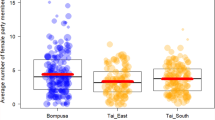Abstract
Competition for food and a safe location in a group are considered to be the main determinants of variation in social relationships among female primates. The effect of the presence of males is usually overlooked, however. Here we put forward two hypotheses connecting the (relative) number of males in a group, a statistic measuring the strength of positive relationships among females (the degree of reciprocity of grooming) and female residence. Under the first hypothesis, we assumed that philopatric females suffer especially from competition for males. Because females of these species are restrained to their native group and thus do not move to groups where better conditions (i.e. more males) prevail, a higher socionomic sex ratio would imply reduced competition and this should be reflected in better relationships among females (i.e. in a higher degree of reciprocation). The second hypothesis is based on the contention of Wrangham (1987) that groups with more males are better able to defend large food sources: in these groups female relationships would suffer less from within-group competition for food. We therefore also expected a positive correlation between the absolute number of males and grooming reciprocation. To test the hypotheses, matrices of grooming interactions were collected by going through the primatological literature. For ten female-resident and four female-transfer primate species, the degree of grooming reciprocation was quantified using a specially adapted matrix statistic. The results favoured the first (competition for males) hypothesis. The degree of grooming reciprocation among females was positively correlated with socionomic sex ratio, but neither with group size nor with the absolute number of males. Correlations between the degree of reciprocity and sex ratio were confirmed at three levels: within the same group at different points in time, between groups of the same species, and between species. In addition, the degree of reciprocation increased with sex ratio more strongly in typical single/variable male than in multi-male species. This we interpreted as a direct consequence of the lower social availability of males for females in multi-male groups than single-male groups. In turn, this effect may be due to males competing for females in multi-male groups.
Similar content being viewed by others
Author information
Authors and Affiliations
Additional information
Received: 28 May 1997 / Accepted after revision: 9 November 1997
Rights and permissions
About this article
Cite this article
Hemelrijk, C., Luteijn, M. Philopatry, male presence and grooming reciprocation among female primates: a comparative perspective. Behav Ecol Sociobiol 42, 207–215 (1998). https://doi.org/10.1007/s002650050432
Issue Date:
DOI: https://doi.org/10.1007/s002650050432




